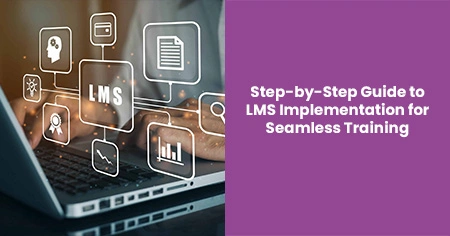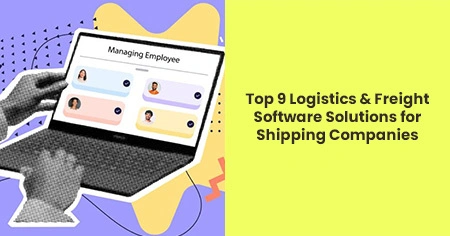Businesses that stay ahead of these shifts can grow more quickly and serve customers more effectively. Those that don't risk losing ground in a competitive landscape. Data, smart systems, and online platforms enable companies to make better decisions and increase profitability.
Many businesses hesitate to implement LMS due to fears of high costs, technical headaches, or poor adoption rates. But with proper planning, it does not have to be a nightmare. LMS Implementation can enhance learning and motivation and give you an opportunity to prove its worth.
In this blog, we will discuss LMS implementation process into uncomplicated and actionable steps, leading you smoothly into a clearly defined training experience without compromising your sanity. So, let us begin.
LMS Implementation Steps You Need to Know
The whole gamut of LMS implementation strategy is not concerned only with choosing software. It is about changing how an organization learns. Poor implementation leads to wasted budgets for training and a system that no one really uses. A seamless and exciting training experience is what gets you results when done well. Here is how to get there.
Step 1: Define Your Goals—Because “Just Get an LMS” Isn’t a Strategy
Goals need to be already defined, for “just get an LMS” is never a strategy. Before running through a dozen software demos, think about what the organization is going to accomplish. Onboarding faster? Tracking compliance? Building up employee skills? If your objectives are clear, you won’t pour money into features that sound nice but need your demands.
Goals that haven’t been defined lead to unclarity, nonacceptance, and frustration. Knowing the “why” makes it easy to measure success. Specify the ways an LMS is going to make things more efficient, cut training costs or advance employee performance. Given these standards, get all necessary stakeholders on board with the key objectives so the LMS takes precedence in the company.
Tip: Tie those goals to business outcomes. This will help you deliver training fast and also make it measurable.
Step 2: Get Stakeholder Buy-In—Or Prepare for a Battle
"People don't resist change. They resist being changed." - Peter Senge.
Resistance from leaders and users kills an LMS faster than anything else. Around 45% of LMS projects fail due to a lack of executive support and alignment with organizational goals. So, you need the top people to sign off on the budget for the LMS implementation; you also need the user groups to see if the LMS will have any real meaning. It will be ignored if the LMS is viewed as another corporate tool.
Unclear articulated advantages, fear of change, past programs with poor reputations—the pushback against LMS systems stems from many quarters. So, you should place your Learning management system (LMS) in the efficiency, growth, and convenience framework. Teach management how to cut down training time and costs with compliance. Show employees how easy, quick, and relevant the learning will be.
Step 3: Choosing the Correct LMS—Because One Size Never Fits All
The wrong LMS will create frustration, waste of valuable money, and little to zero engagement with the users. Another big mistake is to choose a platform for its mere brand reputation instead of business needs. The next trap we easily get into is the distraction of shiny features that may only serve to complicate your learning but offer no real value.
A checklist should be an essential step in the LMS implementation strategy. Does anyone desire mobile learning? Gamification? AI-induced recommendations? Integration with tools already in use? The better the LMS follows the workflow of your organization, the higher its chances of being adopted. Get the vendors in a real-life demonstration of their product, not the slick sales pitch they prefer. If they have a hard time defining their ROI or do not offer a trial, you ought to rethink.
User experience is equally important, if not more so than function. If the employees find it daunting, they won't use it. Therefore, simplicity, ease of use, and strong reporting should be at the top of your priority list.
Step 4: Plan Your Content—No One Wants to Sit Through Hours of Boring Training
Simply pouring some PDFs into an LMS and expecting learners to engage with them is a surefire way to fail. The master plan for effective LMS implementation steps is keeping content interactive, structured, and digestible. You can also check out this research paper which proves the same. When training becomes too much of a burden, employees speed through it or skip it altogether.
Divide content into small bite-sized modules. Use real-world scenarios, videos, and quizzes to deepen understanding. It shouldn't be about stuffing information into someone's ears. Training should be engaging, relevant, and easy to remember. Consider a microlearning strategy where short lessons will focus on one key topic at a time. Tools like Document360 can help organize training materials into well-structured, searchable modules, making it easier for teams to access updated, bite-sized content exactly when they need it.
Tip: The shorter the module, the better. No one wants to consume a 60-minute training video when 5 out of the minute-long microlearning sessions should suffice. If content is irrelevant or outdated, employees won't review it. Regularly, they must be updated to remain relevant.
Step 5: Test Before You Launch—Because Fixing Mistakes Later is a Nightmare
Too often, a rushed implementation of an LMS results in errant bugs that cause confusion and frustration. Testing allows a seamless rollout by identifying problems before they touch a larger segment. Most organizations skip this step, paying for it dearly with disengagement and failure of the said system.
Pilot test your LMS with a small audience who can give feedback on ease of use in navigation, mobile compatibility, and reporting features: Is the content loading correctly, is progress tracking working, do assessments function as expected? Make changes prior to going live with the rest of the company by actual user experience.
What to check: Is navigation intuitive? Do courses work on all devices? Are reports generated easily? Learning is disrupted by post-launched problem-solving—thus, refining everything beforehand. This saves time and prevents hassles.
Step 6: Train Your Trainers—Because “Figure It Out Yourself” Isn’t a Strategy
The best LMS will fail if you don't train your trainers on how to best utilize the system for learner benefits. Most organizations assume that merely introducing the LMS automatically converts staff to its use, but reality isolates such assumptions with meaningful training. Knowing how to work with it and understanding the features will instill confidence and safety in the trainer's mind.
Train well the people who are going to manage the LMS. They should know how to upload content, track learner progress, generate reports, and troubleshoot issues. Strong training guarantees the smooth adoption of the system and increases trust in the platform. If trainers struggle, then the employees are going to lose confidence in the system very quickly.
Tip: Create a single source of truth for trainers where they can find FAQs, best practices, and video tutorials. With a well-trained team, it prevents unnecessary roadblocks and increases overall engagement.
Step 7: Launch & Drive Adoption—Make It Exciting, Not a Chore
A boring rollout of LMS guarantees poor engagement. Employees already carry heavy loads, and if they are 'forced' to do any training, participation will be minimal. Adopting new technology within organizations calls for excitement, communication, and motivation.
Introducing the LMS along with a structured plan for launching it. For example, organize demo sessions online, send out teaser emails, share success stories, and possibly offer incentives to early adopters (recognition or rewards). Make it clear how the LMS benefits the individuals in an organization, whether making it easy to access career development or well-streamlined compliance training.
Provide ongoing support via dedicated support channels, FAQs, or an internal LMS champion. This takes time, but a very good execution does build momentum eventually.
Step 8: Monitor, Improve, Repeat - Because the Work is Not Over
But indeed, implementation is not a one-time affair. Many organizations implement an LMS and think the job is done, only to realize that engagement dwindles within just months. There must be a continuous evaluation of relevance and ongoing improvement.
Monitor essential figures such as course completion rates, quiz results, and training hours. Low participation is a clear disillusionment signal, which indicates content that is too old, usability ailments, or no compelling motivation. It is important to seek continuous feedback to help understand what is not working and optimize the learning experience.
Do not blame the employees for not accessing the LMS: revisit your content strategy. A system that grows with your organization will remain successful for an organization in the long term. Continue refining, renewing, and improving based on real data and user insight.








